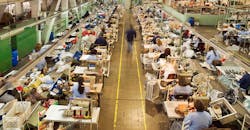Why Can’t The Supply Chain Get Rid of Abuse?
How many years has it been since we first heard about those tragic Foxconn workers who preferred to jump to their deaths from the factory dorms where they lived, rather than continue to work in hazardous conditions?
The answer is eight. In 2010, 18 workers threw themselves from the top of the Chinese company’s building, resulting in 14 deaths. And in 2012 conditions at the plant were still such that workers threatened to commit suicide by leaping from their factory roof in protest of their working conditions.
Foxconn, a high-tech supplier to Apple, Sony, Nintendo and HP, responded at the time by installing safety nets in some of its factories and hiring counselors to help its workers. That’s a solution? And what has improved since then?
Not much.
In January of this year, another Apple supplier, Catcher Technology Co., also based in China, was found in violation of basic working conditions, as it compelled workers to stand for up to 10 hours a day in hot workshops slicing and blasting iPhone casings and handling noxious chemicals, sometimes without proper gloves or masks.
And it’s not just China where these abuses are taking place. In Malaysia last year, for instance, a supplier to Samsung and Panasonic was found confiscating passports of workers and subjecting them to long periods of standing without adequate rest and restricted toilet breaks—a textbook case of modern slavery.
And it’s not just the tech industry where the abuse is happening, either. In the apparel industry, just this past January, luxury fashion retailer Hugo Boss said it found cases of forced labor. Young female workers have been held captive behind the walls of garment factories in southern India.
In the mineral supply chain, particularly in mining gold, children have been injured and killed in mining accidents in smaller scale mines in China, Mali, Tanzania and the Philippines. They have suffered poisoning from mercury used in gold processing, and developed respiratory diseases from exposure to dust.
And let’s not forget about the seafood industry. A report from Human Rights Watch in January found that even four years after it was learned that slaves in Asia were forced to work in this industry for years at a time under threat of extreme violence, it is still happening. Today, seafood sold by major U.S., British and European retailers is being produced under these conditions.
And the U.S. is not exempt from abuse of labor, either. Horrific working conditions endured by children farming tobacco in North Carolina, Kentucky, Tennessee and Virginia were reported in January of this year by Human Rights Watch.
So the abuse is widespread—across countries and industries. I know that most companies are looking into these issues and have corporate social responsibility policies to rid the system of these abuses. And I know it’s very complicated as many people are so desperate for work they endure these conditions.
But I find it hard to believe that there is nothing we as consumers can do about it. Why can’t we boycott companies who are using suppliers who abuse their workforce?
We can and we have done this before. Once the situation of abuse in the diamond mines came to light, people refused to buy them and so today jewelry is advertised as “conflict-free.”
Let’s do that with our clothes, our seafood and our tech products and every other product that is dependent on its creation on suppliers who abuse their workforce.
How many more years we have to wait until people stop wanting to jump off the roofs of their employers?
